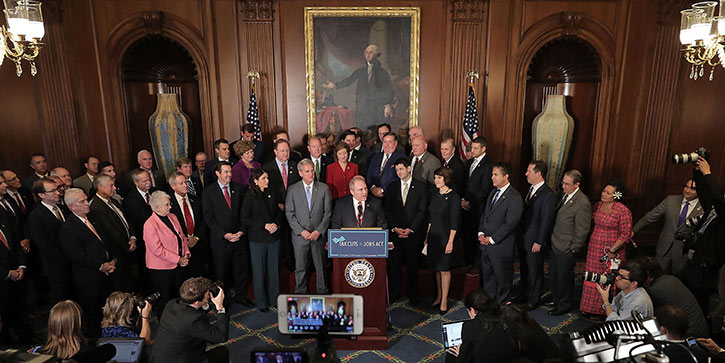According to the more cynical pundits, government programs usually achieve the opposite of their intended goal. And sometimes they do.
For example, Richard Nixon’s “War on Drugs” is still in progress, but the drugs are definitely winning.
Some government programs, however, are more effective. Firefighters are doing a pretty good job extinguishing fires. The US Coast Guard saves lives every day. Public school teachers educate students who would rather be elsewhere.
And then there’s our increasingly dysfunctional Congress. Where to begin?
I’ve written recently how Congress’s new tax plan misses a chance to boost economic growth. Now I think it may be even worse. Instead of merely failing to stimulate growth, the tax changes could actually launch a recession. I’ll tell you why in a moment.
But first, a quick reminder: our Mauldin Economics VIP program is open to new members until December 13. VIP members get all our premium investment services, including my own Yield Shark and Macro Growth & Income Alert, for one low price. I suspect they’ll be even more useful if we go into recession, so click here to learn more.
Long and Weak Expansion
I explained two weeks ago why tax cuts won’t stimulate the economy as much as Republican lawmakers think. Most CEOs say they will use any tax savings for stock buybacks or dividends, not new hiring or expansion.
Since then, the Joint Committee on Taxation, Congress’s nonpartisan scorekeeper, found the Senate tax bill would spur only 0.8% of economic growth, split over 10 years, and add a net $1 trillion to the national debt.
But let’s set aside debt for now. What if, instead of little or no growth, this tax bill sets off an outright contraction?
The current economic expansion is now the third-longest since World War II. It’s also the weakest. Here’s a chart I showed last summer.
The yellow line is the current recovery that began in 2009. Only the 1960s and 1990s growth periods went on longer—and both had much higher growth.
So, just by length of time, we’re already due or overdue for recession. Yes, the economy could improve further from here… but probably not for long.
Potential Achieved
Last week, the Commerce Department revised its third-quarter inflation-adjusted GDP estimate to a 3.3% annualized pace. While that was good news, it also marked something ominous.
In addition to actual gross domestic product, economists track “Potential GDP.” That’s how fast the economy is capable of growing, considering the number of available workers, productivity, and other factors.
If subsequent data confirms last quarter’s 3.3% growth, it will mark the first time since 2007 the US economy achieved “maximum sustainable output.”
The gap between the gray line (potential GDP) and the red line (actual GDP) represents unused capacity. You can see we had a lot of it at the recession’s 2009 depth. The gap slowly shrank since then. Now it’s closed.
Great news, right? Yes, it is—but don’t celebrate just yet.
The End Is Near
Actual GDP can’t stay above potential GDP for long before bad things start happening. This chart proves it:
We see here how GDP moved above and below its potential since the 1970s. Notice that each time the green line went above zero, a recession (the gray bars) began soon after.
“Soon” can vary, of course. GDP ran above potential for extended periods in the late 1990s and 2006–2007, but in both cases, intense downturns followed. Plus, the Fed wasn’t tightening as it is now—which suggests the current expansion is at least approaching its endpoint.
The Trump administration and congressional Republicans disagree, saying their tax changes will stimulate years of economic growth and more than pay for themselves.
President Trump himself said last month he thought growth could reach 4% and even “quite a bit higher.”
I agree we may get a quarter or two of 4% real annualized growth. But will it continue for years? Probably not, unless potential GDP takes a big leap.
Here is the potential GDP chart above, extrapolating the future as it would look with 3–4% growth over the next decade.
I’m sorry this chart is so tall, but that red triangle is necessary to project as much growth as the president anticipates and that Congress says will pay for the tax cuts. The smaller yellow fan below it is the less thrilling estimate of nonpartisan economists.
In either case, to do what the Republicans predict, GDP must grow above potential for years, unless potential GDP rises in a similarly spectacular fashion.
That’s not impossible: a major technology breakthrough might do it, say, a cure for cancer that frees up more workers, or wearable supercomputers to make workers more productive.
But just as likely, a recession, natural disaster, war, or other shock could sharply reduce GDP. The projections above don’t account for that possibility.
Booms Going “Boom”
Actual GDP can outpace potential GDP at the end of a cycle, but by definition, such growth is unsustainable. The inputs to higher production—available workers, productivity—can’t grow fast enough, so those booms end up going “boom.”
Now consider what else is happening.
The Federal Reserve is in tightening mode, both raising short-term interest rates and reducing its massive balance sheet assets. Fed officials think the economy is close to full employment, and they want to control inflation pressure before it gets out of hand.
If this tax cut finally passes—and I’m still dubious that it will—I don’t think it will create anything like 3–4% GDP growth. I think it will do the opposite, as the US Treasury borrows hundreds of billions more dollars to cover deficit spending. That will drive rates higher; not good for real estate or consumer spending.
Much like the War on Drugs gave us more drugs, the “War on Slow Growth” might give us even slower growth.
Recession Triggers
Here’s where we are:
All that is happening even if we get no surprises. War with North Korea, a NAFTA breakup, Chinese banking crisis, a hard Brexit—any of those could extinguish global growth.
My main fear as we entered 2017 was that the Fed would tighten too much and too fast, pushing the economy into a deflationary recession. I still think that’s the most likely scenario.
If this tax bill passes in its current form, the recession may happen sooner and go deeper. The combined fiscal and monetary tightening could be the triggers.
However, first we might get a sugar-high inflationary rally, which could last a while. GDP ran above potential for four years in the late 1990s, and for over a year in the housing craze.
Those were fun times while they lasted. Then the fun stopped.
One thing I’m positive won’t happen is another 10 years of uninterrupted 3% or 4% real GDP growth, as politicians so glibly promise. That’s pure fantasy.
Gravity still applies, no matter how many people wish it didn’t. We may get a demonstration soon.
See you at the top,





